To study the physical state of the atmosphere, both instrumental and visual observations are made. Instrumental observations are carried out with the help of special instruments installed near the surface of the earth at meteorological stations, and instruments raised on rubber balls, airplanes, balloons and kites... Instrumental observations provide information on temperature, humidity, air pressure, wind speed and direction at the surface of the earth and at altitudes up to 30-40 km. In addition, they are used to determine the height of the lower and upper boundaries of the clouds, the amount of precipitation, the composition of the air, the distribution of radiant energy, etc.
Visual observations are carried out at meteorological stations (Fig. 3). In the process of these observations, the shape and amount of clouds (that is, the degree of sky coverage), the horizontal visibility range (the degree of air transparency), the nature of the falling clouds are determined. atmospheric precipitation, intensity of blizzards, etc.
There are also indirect methods for studying the structure of the atmosphere. Indirect methods are mainly used to obtain information about the high layers of the atmosphere, which are still inaccessible for sounding. Indirect methods include observations of light phenomena in the atmosphere, the propagation of sound waves and radio waves. Such light phenomena as auroras, luminosity of the night sky, meteor trails, brightness of the twilight sky, etc., make it possible to judge the density and temperature of the air, the speed and direction of air currents.
Of the indirect methods of studying the atmosphere, the following can also be noted:
by the nacreous clouds the wind and air humidity are determined at the heights of 22-26 km, by the noctilucent clouds - the air currents at the heights of 80-90 km;
temperature, pressure, wind are determined by the abnormal sound propagation; the same elements are determined by meteoric trails at heights of 50-150 km;
by ultraviolet radiation, the ozone content is determined, by the radiation of the night sky - the composition and temperature of the air at altitudes of 60-70 km, by aurora borealis - at altitudes of 80-1000 km.
Meteorological and geophysical rockets determine the pressure, density and temperature of the air, as well as the solar spectrum, etc.
The most widespread radio meteorological device is the radiosonde, an invention of P. A. Molchanov (Fig. 4). Released on a rubber ball into a free atmosphere, the radiosonde in flight registers the pressure, temperature and humidity of the air, and transmits the measurement results by radio with conventional signals. The signals are picked up by radio receivers and decoded by observers. After a quick processing, the values of meteorological elements are obtained at different heights.
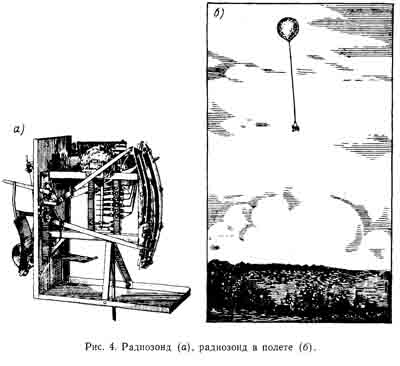
Information about the direction and speed of air currents at heights is obtained with the help of pilot balloons and radio pilots. Pilot balloons are small rubber balloons filled with hydrogen. After they are released into free flight, they are observed in an aerological theodolite. The angle readings are used to calculate the direction and speed of the wind at different heights. In contrast to pilot-balloon observations, carried out in clear weather, radio pilot observations using a radar or radio direction finder allow determining the direction and speed of the wind even in cloudy weather.
The height of the cloud base is measured with pilot balloons and searchlights. For the same purpose, airplanes designed for sounding the atmosphere and ceilometers raised on rubber balls are used.
V last years for the study of the microstructure of clouds and for other purposes, special aircraft-laboratories are equipped.
Almost all of the listed means of observing the physical state of the free atmosphere have been created in the current century, mainly over the past 20-25 years.
Aerology, which is a branch of meteorology, is engaged in the study of physical processes and phenomena occurring in a free atmosphere.
The first information about the structure of the atmosphere was obtained with the help of balloons. In Russia, the first scientific application of the balloon was carried out by Academician Ya.D. Zakharov in 1804. Subsequently, famous scientists D.I.Mendeleev, M.A.Rykachev and others performed flights. (19) August 1877 from the city of Klin.
In our country, the first flight of the stratospheric balloon was made in 1933. The stratospheric balloon "USSR-1" rose to a record height for that time of 19 km (Fig. 5). Another Soviet stratospheric balloon "Osoaviakhim-1" in 1934 reached an altitude of 22 km. The observations made during the flight gave a lot of valuable information about the structure and composition of the air in the lower layers of the stratosphere. The flights of stratospheric balloons in those years were also made in the USA.
Stratostat "USSR-1"
New interesting data on the structural features of the high layers of the atmosphere, as already mentioned, were obtained in the late 40s and 50s with the help of special meteorological and geophysical rockets, artificial satellites Earth and indirect methods of atmospheric research. Especially many launches were carried out during the IGY, IGU and later, i.e., starting from 1957.
Numerous missile launches both in the USSR and abroad were carried out at various points in the northern and southern hemispheres... As a result, for the first time, valuable information was obtained about the high layers of the atmosphere over the Arctic and Antarctica, Europe and Asia, America and Australia, over the oceans. The data obtained in the Arctic, Antarctic and the equatorial zone are especially interesting.
Most meteorological rockets are launched at altitudes of 60-100 km. Geophysical rockets reach much higher altitudes. So, for example, a rocket created in the USSR with a total weight of 2200 kg in May 1957 rose to an altitude of 212 km, and on February 21, 1958, another Soviet rocket with scientific equipment with a total weight of 1520 kg reached an altitude of 473 km. The instruments in the rocket usually return to Earth.
Registration of various meteorological elements and phenomena occurs both during the rapid ascent of the rocket and during the smooth descent by parachute of the container with the equipment separating from it. The observation results are transmitted to Earth using radio telemetry equipment. Scientific instruments record temperature, pressure and chemical composition atmospheres at different heights; they are used to study the physical properties of the ionosphere, cosmic rays, and the short-wavelength ultraviolet part of the solar spectrum.
With the launch of the first artificial satellite of the Earth into the high layers of the atmosphere, along with the study of these layers, the study of the adjacent outer space began. Artificial Earth satellites for studying the atmosphere have significant advantages over meteorological rockets. The latter, being very expensive and complex, allow obtaining information only at a few points of their launch and in short periods of time. Meanwhile, a systematic study of atmospheric processes requires a wide network of stations simultaneously firing rockets — a semblance of the existing network of aerological stations — which is still difficult to implement.
Artificial satellites, despite the difficulties of launching them into orbit, have a number of advantages. Being a scientific laboratory, the satellite, during its many-day flight, registers and transmits by radio information about the composition of the atmosphere, cosmic radiation, the strength of the Earth's magnetic field, the corpuscular radiation of the Sun, etc. the globe at the height of its orbit.
Special meteorological satellites of the Earth take photographs of clouds from an altitude of 300 km or more and thereby register the nature of the weather simultaneously over vast areas of the Earth. According to the data obtained with the help of artificial earth satellites, the components of the heat balance of the atmosphere are calculated, which makes it possible to determine the distribution of temperature and wind at the earth's surface and at heights.
Obviously, a series of meteorological artificial satellites can be launched simultaneously at different altitudes, which will make it possible to obtain data on the features of processes in the high layers of the atmosphere repeatedly and over a long period of time. True, for a long existence of an artificial satellite it is necessary that its orbit be located above the dense layers of the atmosphere, i.e., above 200 km.
Artificial Earth satellites, launched into orbits below 1000 km above the earth's surface, pass through the upper atmosphere. Contacting the atmosphere and experiencing resistance, the satellites gradually lose their speed and move to lower orbits. Artificial earth satellites launched into orbits above 1000 km above the earth's surface can exist for a long time.
The first artificial Earth satellite was launched in the Soviet Union on October 4, 1957 at an altitude of about 900 km, the second on November 3, 1957 at an altitude of 1700 km, and the third on May 15, 1958 at an altitude of 1880 km.
Great prospects in the study of outer space have opened up in connection with the launch of spaceships. The first Soviet satellite spacecraft was launched into orbit on May 15, 1960.The second satellite spacecraft was launched on August 19, 1960, and the third satellite spacecraft was launched on December 1, 1960.
Space rockets are launched to study outer space. The first space rocket weighing 1472 kg was launched in the Soviet Union on January 2, 1959, the second on September 12 (its weight is 1511 kg), and the third on October 4 of the same year (weight is 1553 kg).
The year 1961 was marked by new successes in penetrating the depths of the atmosphere and outer space. On February 12, the Soviet Union launched a rocket to the planet Venus, and on April 12, 1961, the world's first cosmonaut, Yuri Alekseevich Gagarin, flew around the Earth on the Vostok-1 satellite. The flight, which lasted 108 minutes, was admired all over the world.
April 12, 1961 will go down in history as the first day of the era of man's penetration into space. The historical feat of Yuri Gagarin demonstrated the power of the creative genius of the Soviet people.
As you know, already the second spacecraft-satellite weighing up to 4.6 tons safely returned to Earth. There were all the conditions for a man's flight. But complete confidence was needed in the safety of the flight and the return of the astronaut to Earth. Only after a series of launches did Soviet scientists send the first man into space flight. Later in the United States, human flights were carried out in rockets and in a satellite.
The implementation of spacecraft flights is fraught with a number of difficulties. Back in the 17th century. the great Newton determined two values of speed required to determine the force of gravity. One of them - the first space velocity - at the surface of the earth is equal to 8 km / sec. This speed ensures the flight of the launched object around the Earth as an artificial satellite. Another quantity, called the second cosmic speed, is 11 km / sec. Having the second cosmic speed, the launched object overcomes the force of gravity and goes into interplanetary space. These speeds are achieved with multistage rockets.
For a safe manned space flight, interplanetary spacecraft must be controllable, since under this condition it is possible to ensure a return to Earth. But that is not all. It is necessary to create such conditions that the human body can withstand the flight. The human body can easily tolerate any speed. We do not feel the speed of a train, the flight of an aircraft, the movement of the Earth around the Sun (the last speed is about 30 km / sec), etc. But the human body is very sensitive to changes in speed, ie, to acceleration. Some people easily tolerate skiing on the "American" mountains, while others feel worse even when going up and down in an elevator.
The acceleration of the satellite ship is enormous. This leads to an increase in the weight of the astronaut at the moment of take-off by several times. Therefore, in addition to the special training of the body for flight into space, such an ascent regime has been developed, which ensures the safety of the astronaut.
And what effect does weightlessness have on a person?
When launching vertically up to an altitude of 100 km, a person experiences weightlessness for about 3 minutes, when launching up to 200 km - 5-6 minutes, and up to 500 km - about 10 minutes. During the orbital flight of artificial earth satellites, like spacecraft, weightlessness continues continuously.
The flights of experimental animals showed that weightlessness should not noticeably affect the body. After the flight of Yuri Gagarin, the question of the effect of weightlessness on the human body was finally clarified.
Less than four months after the first manned flight into space, Soviet science achieved a new brilliant success in the implementation of space flights.
August 6, 1961 at 9 o'clock Soviet spacecraft-satellite "Vostok-2", piloted by German Stepanovich Titov, in 25 hours. made 17 revolutions around the Earth and, having flown over 700,000 km, on August 7 at 10 o'clock. 18 minutes landed in a given area, near the landing site of the Vostok-1 satellite spacecraft with pilot-cosmonaut Yuri Gagarin.
The flight of the Vostok-2 satellite spacecraft took place in orbit with a minimum distance of the spacecraft from the Earth's surface (at perigee) of 183 km and a maximum distance (at apogee) of 244 km. The flight proved the possibility of a long stay of man in outer space.
On August 11, 1962, the Vostok-3 spacecraft, piloted by the pilot-cosmonaut Andriyan Grigorievich Nikolaev, was launched into the orbit of the Earth satellite in the USSR. The next day, August 12, the Vostok-4 spacecraft with pilot-cosmonaut Pavel Romanovich Popovich was launched into orbit.
The period of revolution of both ships around the Earth was 88.5 minutes. The maximum distance of ships from the Earth's surface (at the apogee) reached 251 and 254 km, respectively, and the minimum (at perigee) - 183 and 180 km.
The world's first group spacecraft flight took place in the ionosphere (thermosphere), about which our knowledge is still very limited.
The Soviet satellite ships landed on August 15 at about 10 o'clock. The flight program was completed in full.
The Vostok-3 spacecraft, having flown around the Earth more than 64 times, covered a distance of over 2.6 million km in 95 hours, and the Vostok-4 spacecraft in 71 hours orbited the Earth more than 48 times, covering a distance of about 2 million km ...
The remarkable flights of Soviet cosmonauts Yuri Gagarin, German Titov, Andriyan Nikolaev, Pavel Popovich, American cosmonaut John Glenn and others showed that in the near future a person will be able to penetrate into interplanetary space and fulfill dreams of flying to the Moon and planets of the solar system.
Presentation on the topic: The atmosphere of the Earth: its composition and structure
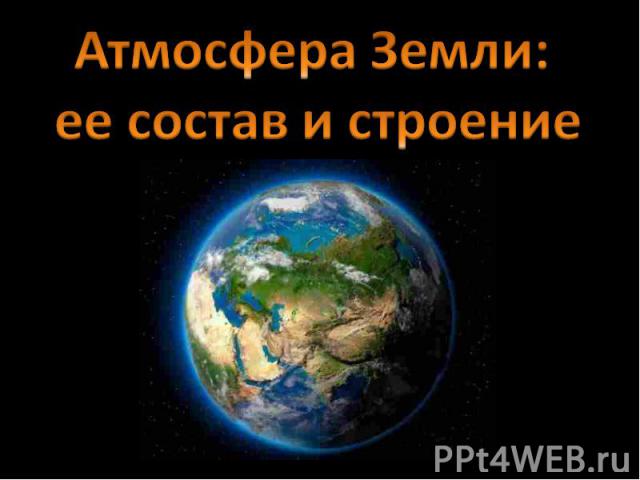


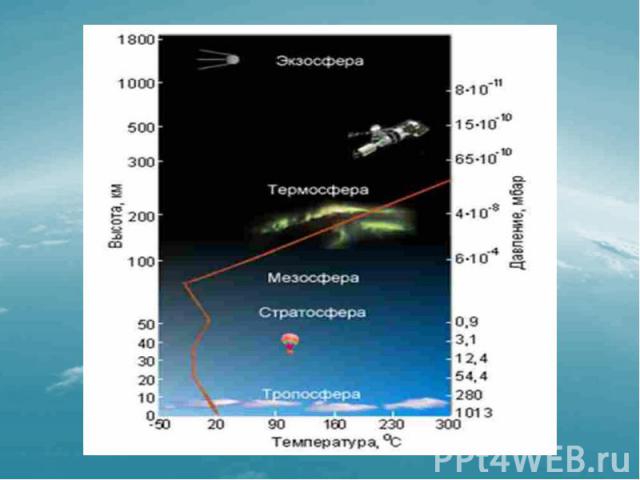
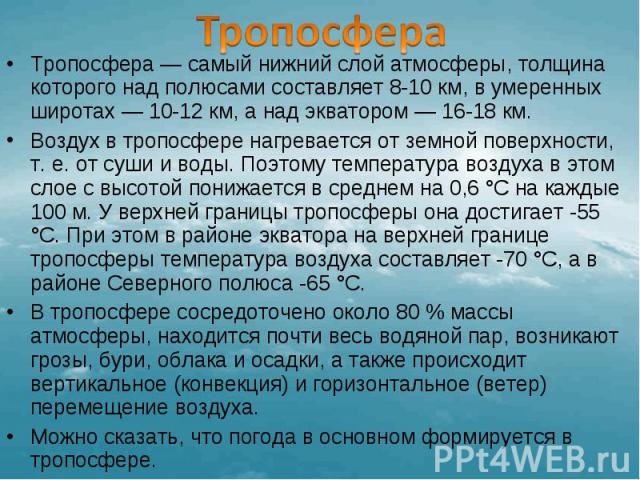

![]()
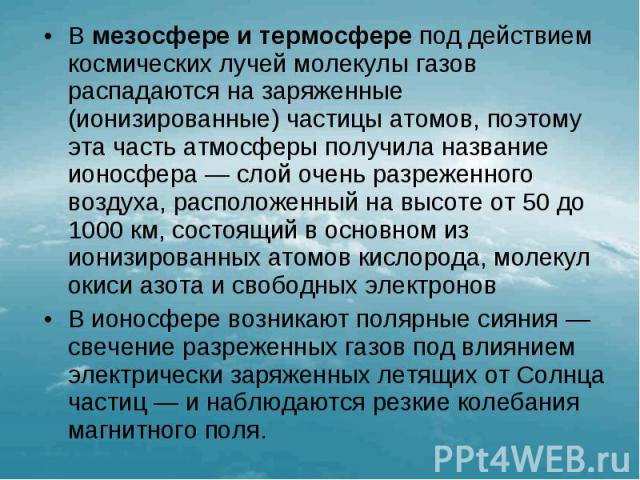
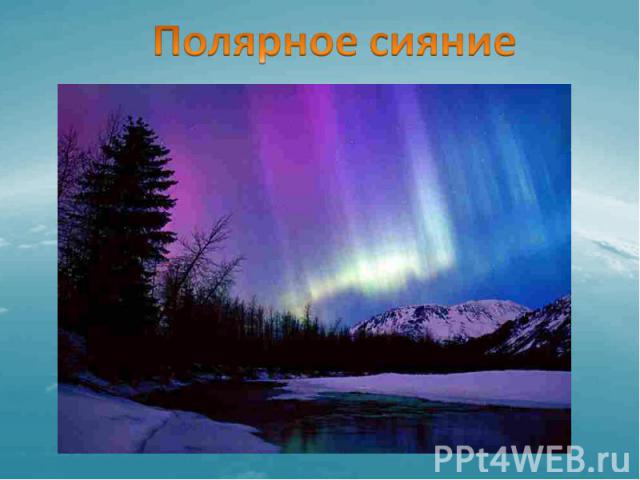
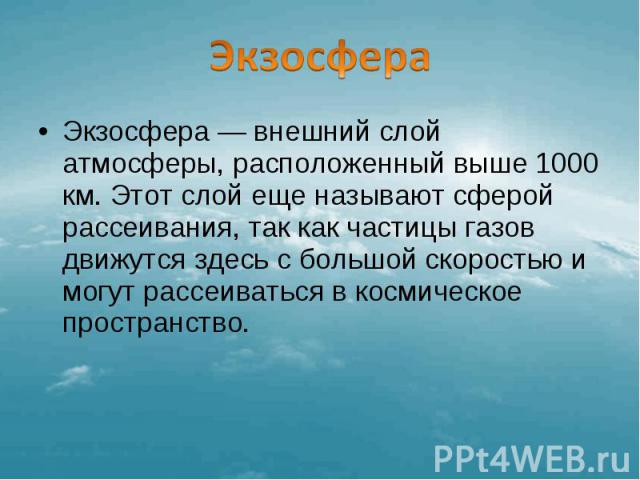
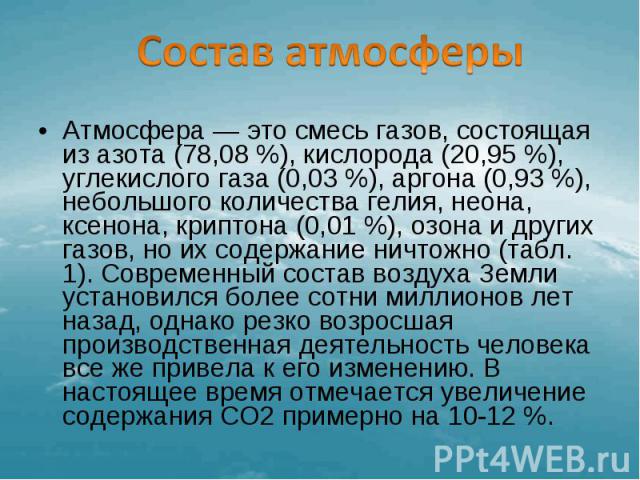
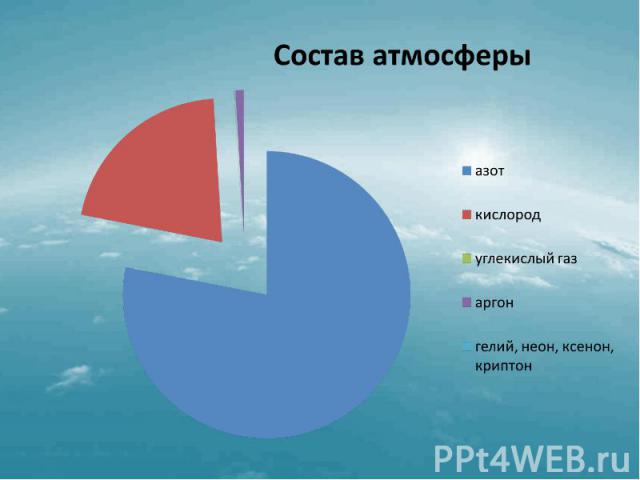
1 of 12
Presentation on the topic: The atmosphere of the Earth: its composition and structure
Slide No. 1

Slide Description:
Slide No. 2

Slide Description:
The atmosphere (from the Greek atmos - steam and spharia - a ball) is the air shell of the Earth, rotating with it. The development of the atmosphere was closely associated with the geological and geochemical processes taking place on our planet, as well as with the activities of living organisms. The atmosphere (from the Greek atmos - steam and spharia - a ball) is the air shell of the Earth, rotating with it. The development of the atmosphere was closely associated with the geological and geochemical processes taking place on our planet, as well as with the activities of living organisms. The lower boundary of the atmosphere coincides with the surface of the Earth, since air penetrates into the smallest pores in the soil and is dissolved even in water. The upper boundary at an altitude of 2000-3000 km gradually passes into outer space. Thanks to the atmosphere, which contains oxygen, life on Earth is possible. Atmospheric oxygen is used in the process of respiration by humans, animals, and plants.
Slide No. 3
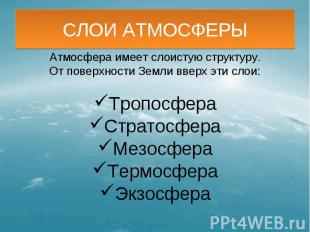
Slide Description:
Slide No. 4
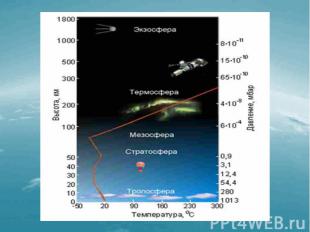
Slide Description:
Slide No. 5
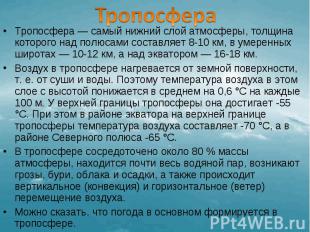
Slide Description:
The troposphere is the lowest layer of the atmosphere, the thickness of which is 8-10 km above the poles, in temperate latitudes- 10-12 km, and above the equator - 16-18 km. The troposphere is the lowest layer of the atmosphere, the thickness of which is 8-10 km above the poles, 10-12 km in temperate latitudes, and 16-18 km above the equator. The air in the troposphere is heated from the earth's surface, that is, from land and water. Therefore, the air temperature in this layer decreases with height by an average of 0.6 ° C for every 100 m. At the upper border of the troposphere, it reaches -55 ° C. At the same time, in the equatorial area at the upper border of the troposphere, the air temperature is -70 ° С, and in the North Pole area -65 ° С. In the troposphere, about 80% of the mass of the atmosphere is concentrated, almost all water vapor is located, thunderstorms, storms, clouds and precipitation occur, and vertical (convection) and horizontal (wind) air movement also occurs. We can say that the weather is mainly formed in the troposphere.
Slide No. 6
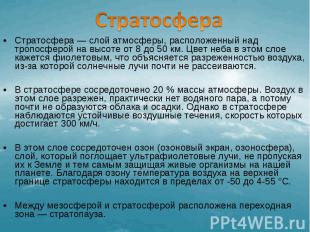
Slide Description:
The stratosphere is a layer of the atmosphere located above the troposphere at an altitude of 8 to 50 km. The color of the sky in this layer appears purple, which is explained by the rarefaction of the air, due to which the sun's rays are almost not scattered. The stratosphere is a layer of the atmosphere located above the troposphere at an altitude of 8 to 50 km. The color of the sky in this layer appears purple, which is due to the rarefaction of the air, due to which the sun's rays are almost not scattered. The stratosphere contains 20% of the mass of the atmosphere. The air in this layer is rarefied, there is practically no water vapor, and therefore almost no clouds and precipitation are formed. However, stable air currents are observed in the stratosphere, the speed of which reaches 300 km / h. Ozone (ozone screen, ozonosphere) is concentrated in this layer, a layer that absorbs ultraviolet rays, preventing them from reaching the Earth and thereby protecting living organisms on our planet. Thanks to ozone, the air temperature at the upper boundary of the stratosphere is in the range from -50 to 4-55 ° C. Between the mesosphere and the stratosphere, there is a transition zone - the stratopause.
Slide No. 7
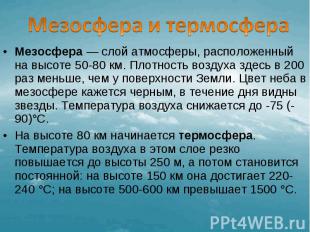
Slide Description:
The mesosphere is a layer of the atmosphere located at an altitude of 50-80 km. The density of air here is 200 times less than at the surface of the Earth. The color of the sky in the mesosphere appears to be black, and stars are visible during the day. The air temperature drops to -75 (-90) ° С. The mesosphere is a layer of the atmosphere located at an altitude of 50-80 km. The density of air here is 200 times less than at the surface of the Earth. The color of the sky in the mesosphere appears to be black, and stars are visible during the day. The air temperature drops to -75 (-90) ° С. The thermosphere begins at an altitude of 80 km. The air temperature in this layer rises sharply to a height of 250 m, and then becomes constant: at an altitude of 150 km, it reaches 220-240 ° C; at an altitude of 500-600 km, it exceeds 1500 ° C.
Slide No. 8

Slide Description:
In the mesosphere and thermosphere, under the action of cosmic rays, gas molecules decay into charged (ionized) atomic particles, therefore this part of the atmosphere is called the ionosphere - a layer of very rarefied air located at an altitude of 50 to 1000 km, consisting mainly of ionized oxygen atoms, molecules nitrogen oxides and free electrons In the mesosphere and thermosphere, under the action of cosmic rays, gas molecules decay into charged (ionized) particles of atoms, therefore this part of the atmosphere is called the ionosphere - a layer of very rarefied air located at an altitude of 50 to 1000 km, consisting mainly of ionized oxygen atoms, nitrogen oxide molecules and free electrons In the ionosphere, auroras arise - the glow of rarefied gases under the influence of electrically charged particles flying from the Sun - and sharp fluctuations of the magnetic field are observed.
Slide No. 11

Slide Description:
The atmosphere is a mixture of gases, consisting of nitrogen (78.08%), oxygen (20.95%), carbon dioxide (0.03%), argon (0.93%), a small amount of helium, neon, xenon, krypton (0.01%), ozone and other gases, but their content is negligible (Table 1). The modern composition of the Earth's air was established more than a hundred million years ago, but the dramatically increased production activity of man still led to its change. Currently, there is an increase in CO2 content by about 10-12%. The atmosphere is a mixture of gases, consisting of nitrogen (78.08%), oxygen (20.95%), carbon dioxide (0.03%), argon (0.93%), a small amount of helium, neon, xenon, krypton (0.01%), ozone and other gases, but their content is negligible (Table 1). The modern composition of the Earth's air was established more than a hundred million years ago, but the dramatically increased production activity of man still led to its change. Currently, there is an increase in CO2 content by about 10-12%.
Astronauts who have seen our planet from space say that it is surrounded by a thin blue haze. This is how the atmosphere looks, the birth of which is still unclear.
Atmosphere composition
The atmosphere (from the Greek words atmos - air, sphaira - ball) is a gas envelope that surrounds the Earth and extends up to 1000 kilometers upward from the earth's surface. It is held by the gravity of the Earth.
The air in the atmosphere is a mixture of gases, tiny water droplets and ice crystals. It also contains particles of dust, soot and organic matter. The main gases of the atmosphere are nitrogen, oxygen and argon. They make up 99.9% of the mass of atmospheric air. Their ratio at the earth's surface is the same in different areas Earth. This is due to the strong mixing of the air.
Several layers are distinguished in the atmosphere. They differ in many properties, and above all in the characteristics of temperature change. The lower layers of the atmosphere - the troposphere and stratosphere - contain almost all of the Earth's air. Troposphere - directly adjacent to the earth's surface. Its upper boundary above the equator is at an altitude of 18 kilometers, and above the poles - at an altitude of 8-9 kilometers. The troposphere contains more than 4/5 of all atmospheric air, contains almost all water vapor. Here horizontal and vertical air movements occur, clouds are formed, bringing rain and snow. The temperature in the troposphere gradually decreases from bottom to top and averages -55 ° C at the border with the stratosphere. Life of humans, plants and animals takes place in the troposphere.
The stratosphere extends to an altitude of 50-55 kilometers. The air in it is so thin that they cannot breathe. Visibility in this layer is always good, there are almost no clouds, there are no thunderstorms, no rain, no snow. Therefore, the paths of modern aircraft run in the lower layers of the stratosphere. In the lower part of the stratosphere, the temperature is more or less constant, but from a height of 25 kilometers it begins to rise and at the upper boundary of the layer is close to 0 ° С.
Above the stratosphere are the upper layers of the atmosphere. The temperature here is lowered and at an altitude of 80 kilometers it reaches a minimum of -80 ° C. The air at this altitude is so thin that it does not absorb solar heat and does not scatter light.
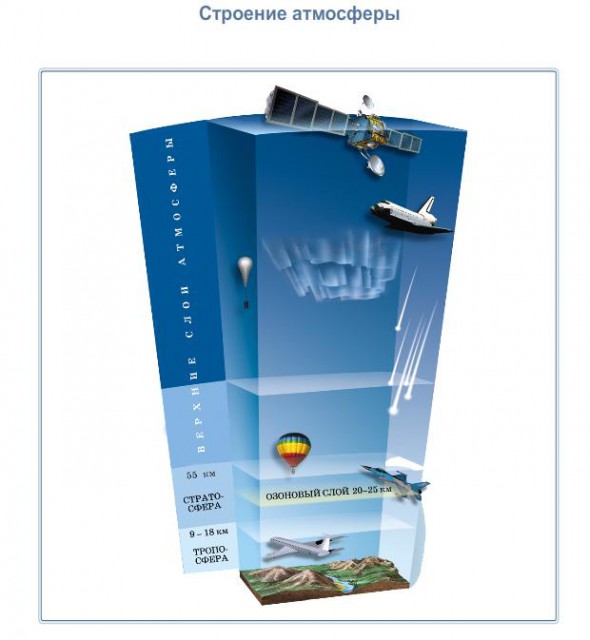
Above, the temperature in the atmosphere rises rapidly and at an altitude of 500-600 kilometers it is +1500 ° C. Therefore, according to the temperature characteristic, a layer called the thermosphere is distinguished in the upper atmosphere. Atmospheric heights from 100 to 1000 kilometers are called the ionosphere. Here, under the influence of ultraviolet rays coming from the Sun, gas particles are strongly electrified. The glow of these particles causes the aurora.
Earth is the only planet that has a gas envelope that contains oxygen necessary for breathing. For most living organisms, the atmosphere is the environment for life. We can say that plants, animals and people live not only on the solid surface of the Earth, but also at the bottom of the "air ocean". The atmosphere protects the planet from harmful cosmic radiation and small meteorites that burn up in it before reaching the Earth's surface. A significant part of solar energy is spent on heating the surface air layer. The atmosphere retains heat at the earth's surface, like a blanket protects it from excessive overheating and hypothermia. Water evaporated from the surface forms clouds in the troposphere, which also protect the Earth from overheating. They reflect part of the sun's rays and bring
On the history of exploration of the upper layers of the Earth's atmosphere
We live at the bottom of an aerial ocean that stretches upwards for thousands of kilometers. And all that we observe weather conditions occur in its lowest, thinnest layer - the troposphere. Its thickness in height in temperate latitudes is 10 - 12 km, in polar latitudes 8 - 10 km and 16 - 18 km in the tropics. Compared to the length of the entire thickness of the atmosphere, this is negligible. But in the troposphere, as noted above, all our weather is concentrated with all the variety of phenomena and circulations. It also contains 4/5 of the total mass of atmospheric air.
Nevertheless, the overlying layers of the earth's atmosphere are no less important for all life on our planet. The ozone layer located in the layer next to the troposphere - the stratosphere - is a reliable barrier on the way to the Earth's surface, which is fatal for all living ultraviolet radiation. In addition, it was found that interannual variations in total ozone (TO) on a global scale are indicators of climate change. And according to the changes in the CCA in individual geographic locations it is possible to judge the upcoming surface temperature anomalies in geographic regions remote from this point in the long term (up to 40 days), which, undoubtedly, over time can be used for more accurate long-term weather forecasts.
For the study of the upper layers of the atmosphere, various indirect methods have been used for a long time, which include, first of all, observations of the propagation of sound waves, the twilight sky, meteor trails, movement, etc.
In 1930, for the first time to study the atmosphere, a radiosonde was released, invented by the Soviet meteorologist P.A. Molchanov, and in 1933 G.A. Prokofiev, K. D. Godunov and E.K. Birnbaum climbed on the stratospheric balloon "USSR-1" to an altitude of 19 km.
But records of scientific observations have survived.
In the 40s – 50s of the last century, thanks to technical progress and the equipping of meteorology with radio technical means, it became possible to directly measure many parameters of the atmosphere at heights, first up to 20–30 km, and then up to 60–100 km. The launches of meteorological rockets and artificial earth satellites have significantly expanded these capabilities.
High radiosonde rises made it possible to make important discovery in the stratosphere. Significant seasonal (monsoon) changes in the equator-pole temperature gradient and associated changes in the pressure and wind regime were found.
An important milestone was the International Geophysical Year, which lasted from July 1, 1957 to December 31, 1958. Scientists from 64 countries conducted research on the Earth according to a single program. During this time, 112 meteorological and 13 geophysical rockets were launched in the USSR. The data obtained by international teams of scientists made it possible to study in detail the structure of the atmosphere and the features of its circulation up to an altitude of 20-30 km.
High-altitude observations in the upper equatorial stratosphere revealed a multicyclicity of air currents - quasi-two-year in the lower stratosphere and six-month in the upper. Moreover, both cycles are in a certain relationship.
February 21, 1958 in the USSR, a meteorological rocket weighing 1520 kg was launched, which reached a record height for single-stage missiles of this class - 473 km, and at the end of the summer of the same year, the rocket rose to an altitude of 450 km, weighing 1690 kg.
The use of meteorological and geophysical rockets in atmospheric research has allowed scientists to obtain reliable data up to an altitude of about 80 - 100 km.
Essentially new data on phenomena in near-earth space were obtained using the automatic interplanetary stations Luna-1, Luna-2 and Luna-3, launched on January 2, September 12 and October 4, 1959, respectively. This is how the hydrogen geocrown was discovered, stretching 20 thousand kilometers from the Earth.
The scientific information obtained has shown that there are several layers in the atmosphere, which differ from each other primarily and most clearly in the nature of the vertical temperature distribution. And if at the beginning of the 20th century it was customary to divide the atmosphere only into two parts: the troposphere (lower layer) and the stratosphere, which initially meant all layers of the atmosphere located above the troposphere, now, on the recommendation of the World Meteorological Organization (WMO), it is customary to divide the atmosphere to the troposphere, stratosphere, mesosphere, thermosphere and exosphere.
About the discovery of the ozone layer
Scientists have long established that the solar spectrum is constantly cut off in the ultraviolet part at the same wavelength. The atmosphere turned out to be opaque for even shorter waves. The reason for this remained unclear for a long time, since no gas was known below in the composition of the atmosphere that would not allow ultraviolet rays to pass through. Finally, in 1840, such a gas was found in one of the physics laboratories. By decomposing water into its constituent parts - oxygen and hydrogen, it was possible to obtain a new gas with an extremely strong characteristic odor. He was called “strong smelling”, in Greek “ozone”.
Studies have shown that with a rise above the earth's surface, the ozone content first changes irregularly, and only from an altitude of 10 km it is planned to increase, especially clearly pronounced above 12-15 km. At an altitude of 20 - 25 km, the maximum ozone content is observed, and above the amount of ozone gradually decreases and becomes negligible at an altitude of 55 - 60 km.
How did you get the data on the ozone content at altitudes? First, by analyzing air samples taken at altitudes. Second, the optical method by measuring the intensity of the absorption bands of ozone. First, on stratospheric balloons, and later with the help of rockets, a spectrograph was raised into the overlying layers of the atmosphere, recording the solar spectrum. From the intensity of absorption in the ultraviolet region of the spectrum, it is possible to determine the change in the amount of ozone with height.
Literature:
P.N. Tverskoy. Meteorology course. Hydrometeoizdat, 1962.
Atmosphere of the Earth. Collection. Moscow, 1953.
A.L. Katz. Circulation in the stratosphere and mesosphere. Hydrometeoizdat, 1968.
The materials of the journals "Meteorology and Hydrology" and "Science and Life" were also used.
>> Atmosphere of Earth
For the little ones it is already known that the Earth is the only planet in our system that has a viable atmosphere. The gas blanket is not only rich in air, but also protects us from excessive heat and solar radiation... Important explain to children that the system is designed incredibly well, because it allows the surface to warm up during the day and cool down at night, while maintaining an acceptable balance.
Begin explanation for children it is possible with the fact that the globe of the earth's atmosphere extends over 480 km, but most of it is 16 km from the surface. The higher the altitude, the lower the pressure. If we take sea level, then the pressure there is 1 kg per square centimeter. But at an altitude of 3 km, it will change - 0.7 kg per square centimeter. Of course, in such conditions it is more difficult to breathe ( children could feel it if they ever went hiking in the mountains).
Air composition
Among the gases are distinguished:
- Nitrogen - 78%.
- Oxygen - 21%.
- Argon - 0.93%.
- Carbon dioxide - 0.038%.
- In small quantities, there is also water vapor and other impurities of gases.
Atmospheric layers
Parents or teachers at school should recall that the earth's atmosphere is divided into 5 levels: exosphere, thermosphere, mesosphere, stratosphere and troposphere. With each layer, the atmosphere dissolves more and more until the gases are finally dispersed in space.
Troposphere - is closest to the surface. With a thickness of 7-20 km, it makes up half of the earth's atmosphere. The closer to the Earth, the more the air warms up. Almost all water vapor and dust is collected here. Children may not be surprised that it is at this level that clouds float.
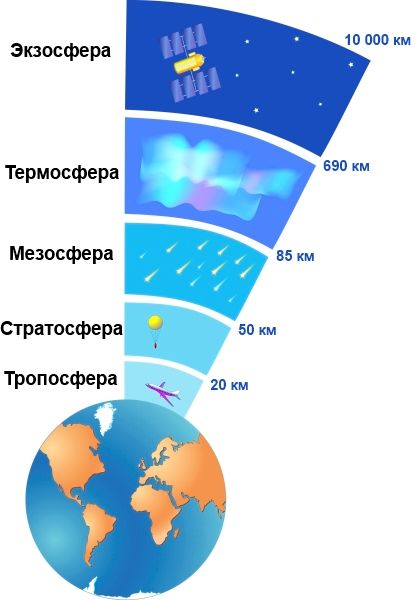
The stratosphere starts from the troposphere and rises 50 km above the surface. There is a lot of ozone here, which heats the atmosphere and saves from harmful solar radiation. The air is 1000 times thinner than above sea level and is unusually dry. That is why airplanes feel great here.
Mesosphere: 50 km to 85 km above the surface. The summit is called the mesopause and is the coolest place in the earth's atmosphere (-90 ° C). It is very difficult to investigate, because they cannot get there. jet aircraft, and the orbital altitude of the satellites is too high. Scientists only know what is being burned down here.
Thermosphere: 90 km and between 500-1000 km. The temperature reaches 1500 ° C. It is considered part of the earth's atmosphere, but it is important explain to children that the density of the air here is so low that most of it is already perceived as outer space. In fact, this is where the space shuttles and the International space station... In addition, auroras are formed here. The charged cosmic particles come into contact with the atoms and molecules of the thermosphere, transferring them to a higher energy level. Thanks to this, we see these photons of light in the form of aurora borealis.
 The exosphere is the highest layer. An incredibly thin line of merging of the atmosphere with space. Consists of widely dispersed hydrogen and helium particles.
The exosphere is the highest layer. An incredibly thin line of merging of the atmosphere with space. Consists of widely dispersed hydrogen and helium particles.
Climate and weather
For the little ones necessary explain that the Earth manages to retain many living species thanks to the regional climate, which is represented by extreme cold at the poles and tropical heat at the equator. Children should know that the regional climate is the weather, which in a particular area remains unchanged for 30 years. Of course, sometimes it can change for several hours, but for the most part it remains stable.
In addition, the global terrestrial climate- average regional. It has changed throughout human history. Today there is a rapid warming. Scientists are sounding the alarm as greenhouse gases caused by human activity trap heat in the atmosphere, risking turning our planet into Venus.




